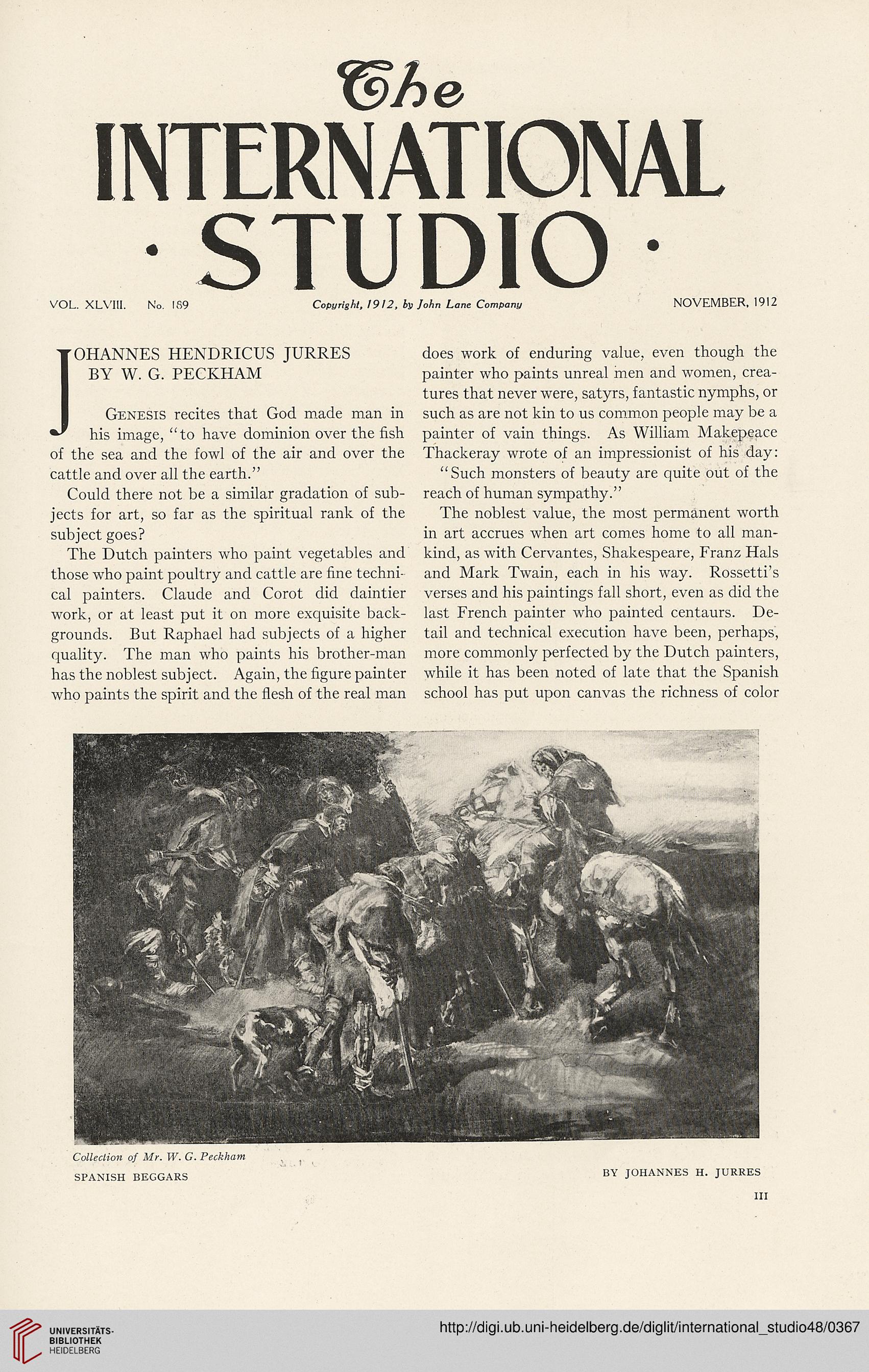INTERNATIONAL
• STUDIO
VOL. XLVIII. No. 189 Copyright, 1912, by John Lane Company NOVEMBER, 1912
OHANNES HENDRICUS JURRES
BY W. G. PECKHAM
Genesis recites that God made man in
his image, “to have dominion over the fish
of the sea and the fowl of the air and over the
cattle and over all the earth.”
Could there not be a similar gradation of sub-
jects for art, so far as the spiritual rank of the
subject goes?
The Dutch painters who paint vegetables and
those who paint poultry and cattle are fine techni-
cal painters. Claude and Corot did daintier
work, or at least put it on more exquisite back-
grounds. But Raphael had subjects of a higher
quality. The man who paints his brother-man
has the noblest subject. Again, the figure painter
who paints the spirit and the flesh of the real man
does work of enduring value, even though the
painter who paints unreal men and women, crea-
tures that never were, satyrs, fantastic nymphs, or
such as are not kin to us common people may be a
painter of vain things. As William Makepeace
Thackeray wrote of an impressionist of his day:
“Such monsters of beauty are quite out of the
reach of human sympathy.”
The noblest value, the most permanent worth
in art accrues when art comes home to all man-
kind, as with Cervantes, Shakespeare, Franz Hals
and Mark Twain, each in his way. Rossetti’s
verses and his paintings fall short, even as did the
last French painter who painted centaurs. De-
tail and technical execution have been, perhaps,
more commonly perfected by the Dutch painters,
while it has been noted of late that the Spanish
school has put upon canvas the richness of color
Collection of Mr. W. G. Peckham
SPANISH BEGGARS BY JOHANNES H. JURRES
III
• STUDIO
VOL. XLVIII. No. 189 Copyright, 1912, by John Lane Company NOVEMBER, 1912
OHANNES HENDRICUS JURRES
BY W. G. PECKHAM
Genesis recites that God made man in
his image, “to have dominion over the fish
of the sea and the fowl of the air and over the
cattle and over all the earth.”
Could there not be a similar gradation of sub-
jects for art, so far as the spiritual rank of the
subject goes?
The Dutch painters who paint vegetables and
those who paint poultry and cattle are fine techni-
cal painters. Claude and Corot did daintier
work, or at least put it on more exquisite back-
grounds. But Raphael had subjects of a higher
quality. The man who paints his brother-man
has the noblest subject. Again, the figure painter
who paints the spirit and the flesh of the real man
does work of enduring value, even though the
painter who paints unreal men and women, crea-
tures that never were, satyrs, fantastic nymphs, or
such as are not kin to us common people may be a
painter of vain things. As William Makepeace
Thackeray wrote of an impressionist of his day:
“Such monsters of beauty are quite out of the
reach of human sympathy.”
The noblest value, the most permanent worth
in art accrues when art comes home to all man-
kind, as with Cervantes, Shakespeare, Franz Hals
and Mark Twain, each in his way. Rossetti’s
verses and his paintings fall short, even as did the
last French painter who painted centaurs. De-
tail and technical execution have been, perhaps,
more commonly perfected by the Dutch painters,
while it has been noted of late that the Spanish
school has put upon canvas the richness of color
Collection of Mr. W. G. Peckham
SPANISH BEGGARS BY JOHANNES H. JURRES
III





